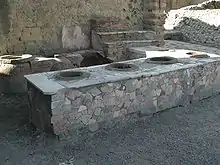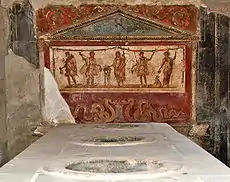Thermopolium
In the ancient Greco-Roman world, a thermopolium (plural thermopolia), from Greek θερμοπώλιον (thermopōlion), i.e. cook-shop,[1] literally "a place where (something) hot is sold", was a commercial establishment where it was possible to purchase ready-to-eat food. In Latin literature they would also be called popinae, cauponae, hospitia or stabula, but archaeologists call them all thermopolia.[2] Thermopolia being the forerunners of today's restaurant, the items served are sometimes compared to modern fast food. These places were mainly used by those who simply could not afford a private kitchen, often inhabitants of insulae, sometimes leading them to be scorned by the upper class.

Design
A typical thermopolium would consist of a small room attached to, but not accessible from, a house, with a distinctive masonry counter in the front.[3] An example of this can be seen in Ostia in the House of the Painted Vaults. Embedded in this counter were earthenware jars (called dolia) used to store dried food like nuts (hot food would have required the dolia to be cleaned out after use, and because they are embedded in the counter, it is believed that they were not used to store hot food, but rather dried food where cleaning wouldn't be necessary).[2] A dolium in the thermopolium attached to the House of Neptune and Amphitrite in Herculaneum had the carbonized remains of nuts.[2] Fancier thermopolia would also be decorated with frescoes.
Well-preserved ruins of thermopolia can be seen in Pompeii, Herculaneum and Ostia.
Thermopolium of Asellina

The Thermopolium of Asellina is one of the most complete examples of a thermopolium in Pompeii. Complete jugs and dishes were found on the counter, as well as a kettle filled with water. The ground floor in the Thermopolium of Asellina was used for people to eat and drink, and some stairs led to guest rooms on the second floor.[4]
It had a typical structure consisting of a wide doorway open to the street and a counter with holes where four jars were set into it (dolia) for food or wine. It had shrines for the Lares (household gods), Mercury (god of commerce) and Bacchus (god of wine), as these were the most important gods for this occupation. Upstairs, there were guest rooms as well, so this may have also been used as an Inn; however, some think that this may have been a brothel due to the names of many women written as a part of an election notice on one of the outside walls of the thermopolium. Another theory is that these were the slave-girls who worked as barmaids. Behind the bar were remains of wooden racks suspended from the ceiling to stack amphorae.[2]
The Thermopolium of Regio V
Another Pompeiian thermopolium, containing eight dolia, was completely unearthed in 2020.[5] In addition to frescoes reflecting foods available, one fresco depicts a dog with a collar on a leash, possibly a reminder for customers to leash their pets. The complete skeleton of an "extremely small" adult dog was also discovered that "attest to selective breeding in the Roman epoch to obtain this result."[6] Archaeologists also revealed about 2,000-year-old foods available in some of the deep terra cotta jars, drink shop, a decorated bronze drinking bowl known as a patera, wine flasks, amphora, ceramic jars used for cooking stews and soups.[7][8][9]
References
- θερμοπώλιον. Liddell, Henry George; Scott, Robert; A Greek–English Lexicon at the Perseus Project
- Berry 2007, p. 230.
- Clarke, John R. (1991). The houses of Roman Italy, 100 B.C.-A.D. 250 : ritual, space, and decoration. Berkeley, CA, US: University of California Press. p. 297. ISBN 9780520914445. OCLC 44962701. Partial preview at Google Books
- Berry 2007, pp. 231-232.
- "THE SNACK BAR OF REGIO V RESURFACES IN ITS ENTIRETY WITH SCENES OF STILL LIFE, FOOD RESIDUES, ANIMAL BONES AND VICTIMS OF THE ERUPTION". Pompeii Site. Retrieved 24 January 2021.
- D'EMILIO, FRANCES (26 December 2020). "Mallard to go? Dig of Pompeii fast-food place reveals tastes". AP NEWS. Associated Press. Retrieved 27 December 2020.
- "Archaeologists uncover ancient street food shop in Pompeii". Hindustan Times. 2020-12-26. Retrieved 2021-01-10.
- "Mallard to go? Dig of Pompeii fast-food place reveals tastes". AP NEWS. 2020-12-26. Retrieved 2021-01-10.
- "Archaeologists unveil ancient street food shop in Italy's Pompeii". english.alarabiya.net. Retrieved 2021-01-10.
- Ward-Perkins, John Bryan; Claridge, Amanda (1978). "Pompeii A.D. 79 : treasures from the National Archaeological Museum, Naples, and the Pompeii Antiquarium". Boston, MA, US: Boston Museum of Fine Arts. p. 94–95 . OCLC 1036826405.
- "Caupona of Salvius · Roman Cauponae". Food and Drink in the Ancient World. Retrieved 2020-12-28.
- Mau, Augus (1902) [1899]. Pompeii, Its Life and Art. Translated by Kelsey, Francis W. New York & London: MacMillan Company. p. 402. OCLC 914185862 – via Project Gutenberg.
Further reading
- Ellis, Steven J. R. (2004). "The Distribution of Bars at Pompeii: Archaeological, Spatial and Viewshed Analyses". Journal of Roman Archaeology. 17: 371–384. doi:10.1017/s104775940000831x. ISSN 1047-7594.
External links
| Wikimedia Commons has media related to thermopolium. |